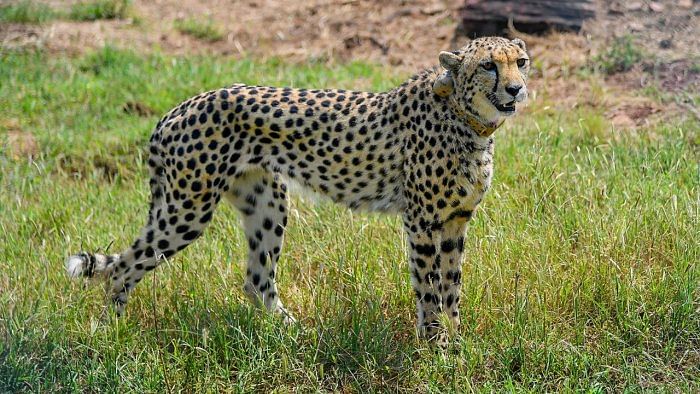
The National Tiger Conservation Authority on Monday decided to examine all cheetahs at Kuno national park to find out if any one of them developed radio collar related abrasion marks that can lead to more serious injuries if left untreated, even as Madhya Pradesh government took action against a top official looking after Kuno.
The state removed J S Chouhan, the principal chief conservator of forest (wildlife) who was overseeing the cheetah translocation programme at Kuno national park. He has been replaced by Aseem Srivastava.
The shifting comes in the wake of two cheetah deaths last week, taking the toll to eight including, three cubs born in India. Chauhan rushed to Kuno two days back and returned to Bhopal on Monday. He has now been made PCCF (production).
The NTCA officials didn’t speak on the outcome of the emergency meet, but sources said there was a broad agreement on checking each feline as the way forward.
“The meeting was very positive. There was broad participation by the international partners and all agreed on the way forward. Basically all the cheetahs need to be assessed as soon as possible and then we will decide on what needs to be done on a case by case basis,” Adrian Tordiffe, a veterinary wildlife specialist at the University of Pretoria, and one of the advisers to the Indian cheetah project who spoke at the NTCA meet told DH.
Tordiffe said as a part of the assessment process, each of free-raging cheetahs would be tranquilised and checked.
“Removal of the collar will depend on the severity of the condition in each animal. If there are no wounds on an animal then the park authorities may leave the collar on. But each animal must be checked and that will require darting of each animal for a thorough inspection,” he said.
The decision comes in the wake of veterinarians and wildlife experts observing that deaths of two cheetahs within 72 hours were due to skin inflammation in the neck, caused by wet collars, causing injuries. This was further aggravated by flies that laid eggs and produced maggots, which in turn spread the injury leading to bacterial invasion.
The latest NTCA decision to screen all cheetahs comes a day after the conservation body attributed “natural causes” as the reason behind all feline deaths at Kuno while describing the suggestions on radio-collar related infections as “only speculation and hearsay.”
Congress leader and former Union Minister Jairam Ramesh described the NTCA’s Sunday statement as a “political one, intended to whitewash management failures and mock conservation science.”
“Predictably the Prime Minister must have intervened and got the NTCA to issue the (Sunday) statement attributing all 8 cheetah deaths so far at Kuno to 'natural' causes. The statement is clearly a political one, intended to whitewash management failures and mocks conservation science. There appears to be enough evidence to expose the NTCA statement,” he tweeted.
Suraj, a male South African cheetah that died on July 14 had maggot infested wounds on the neck and back. Tejas, another South African cheetah that died on July 11 also had injury marks, which Tordiffe believed was caused by skin infections, but the park authorities claimed those marks were caused by attacks from a female cheetah.
"The hypothesis that the female cheetah has killed the male cheetah has stumped virtually all the cheetah biologists,” said an Indian wildlife biologist.
India brought 20 adult cheetahs from South Africa and Namibia in an effort to re-establish a viable cheetah population seven decades after Asiatic cheetahs went extinct from India.
